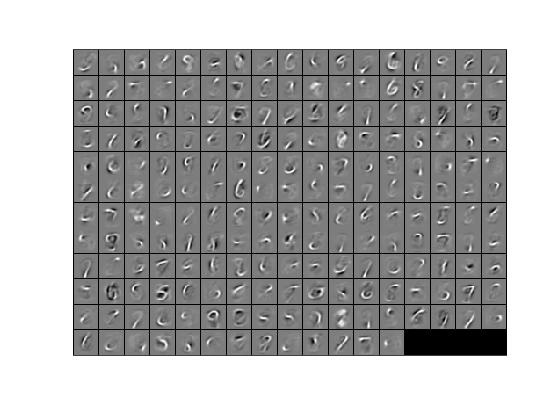这是无监督特征学习和深度学习(UFLDL)的作业题。
本次练习在基于以往练习的基础需要完成stlExercise.m和feedForwardAutodecoder.m的部分内容。
stlExercise.m
%% CS294A/CS294W Self-taught Learning Exercise
% Instructions
% ------------
%
% This file contains code that helps you get started on the
% self-taught learning. You will need to complete code in feedForwardAutoencoder.m
% You will also need to have implemented sparseAutoencoderCost.m and
% softmaxCost.m from previous exercises.
%
%% ======================================================================
% STEP 0: Here we provide the relevant parameters values that will
% allow your sparse autoencoder to get good filters; you do not need to
% change the parameters below.
inputSize = 28 * 28;
numLabels = 5;
hiddenSize = 200;
sparsityParam = 0.1; % desired average activation of the hidden units.
% (This was denoted by the Greek alphabet rho, which looks like a lower-case "p",
% in the lecture notes).
lambda = 3e-3; % weight decay parameter
beta = 3; % weight of sparsity penalty term
maxIter = 400;
%% ======================================================================
% STEP 1: Load data from the MNIST database
%
% This loads our training and test data from the MNIST database files.
% We have sorted the data for you in this so that you will not have to
% change it.
% Load MNIST database files
mnistData = loadMNISTImages('mnist/train-images-idx3-ubyte');
mnistLabels = loadMNISTLabels('mnist/train-labels-idx1-ubyte');
% Set Unlabeled Set (All Images)
% Simulate a Labeled and Unlabeled set
labeledSet = find(mnistLabels >= 0 & mnistLabels <= 4);
unlabeledSet = find(mnistLabels >= 5);
numTrain = round(numel(labeledSet)/2);
trainSet = labeledSet(1:numTrain);
testSet = labeledSet(numTrain+1:end);
unlabeledData = mnistData(:, unlabeledSet);
trainData = mnistData(:, trainSet);
trainLabels = mnistLabels(trainSet)' + 1; % Shift Labels to the Range 1-5
testData = mnistData(:, testSet);
testLabels = mnistLabels(testSet)' + 1; % Shift Labels to the Range 1-5
% Output Some Statistics
fprintf('# examples in unlabeled set: %d\n', size(unlabeledData, 2));
fprintf('# examples in supervised training set: %d\n\n', size(trainData, 2));
fprintf('# examples in supervised testing set: %d\n\n', size(testData, 2));
%% ======================================================================
% STEP 2: Train the sparse autoencoder
% This trains the sparse autoencoder on the unlabeled training
% images.
% Randomly initialize the parameters
theta = initializeParameters(hiddenSize, inputSize);
%% ----------------- YOUR CODE HERE ----------------------
% Find opttheta by running the sparse autoencoder on
% unlabeledTrainingImages
%opttheta = theta;
addpath minFunc/
options.Method = 'lbfgs';
options.maxIter = maxIter;
options.diaplay = 'on';
[opttheta, cost] = minFunc( @(p) sparseAutoencoderCost(p, ...
inputSize, hiddenSize, ...
lambda, sparsityParam, ...
beta, unlabeledData), ...
theta, options);
%% -----------------------------------------------------
% Visualize weights
W1 = reshape(opttheta(1:hiddenSize * inputSize), hiddenSize, inputSize);
display_network(W1');
%%======================================================================
%% STEP 3: Extract Features from the Supervised Dataset
%
% You need to complete the code in feedForwardAutoencoder.m so that the
% following command will extract features from the data.
trainFeatures = feedForwardAutoencoder(opttheta, hiddenSize, inputSize, ...
trainData);
testFeatures = feedForwardAutoencoder(opttheta, hiddenSize, inputSize, ...
testData);
%%======================================================================
%% STEP 4: Train the softmax classifier
softmaxModel = struct;
%% ----------------- YOUR CODE HERE ----------------------
% Use softmaxTrain.m from the previous exercise to train a multi-class
% classifier.
% Use lambda = 1e-4 for the weight regularization for softmax
% You need to compute softmaxModel using softmaxTrain on trainFeatures and
% trainLabels
options.maxIter = 100;
softmaxModel = softmaxTrain(hiddenSize, numLabels, 1e-4, ...
trainFeatures, trainLabels, options);
%% -----------------------------------------------------
%%======================================================================
%% STEP 5: Testing
%% ----------------- YOUR CODE HERE ----------------------
% Compute Predictions on the test set (testFeatures) using softmaxPredict
% and softmaxModel
[pred] = softmaxPredict(softmaxModel, testFeatures);
%% -----------------------------------------------------
% Classification Score
fprintf('Test Accuracy: %f%%\n', 100*mean(pred(:) == testLabels(:)));
% (note that we shift the labels by 1, so that digit 0 now corresponds to
% label 1)
%
% Accuracy is the proportion of correctly classified images
% The results for our implementation was:
%
% Accuracy: 98.3%
%
%
feedForwardAutodecoder.m
function [activation] = feedForwardAutoencoder(theta, hiddenSize, visibleSize, data)
% theta: trained weights from the autoencoder
% visibleSize: the number of input units (probably 64)
% hiddenSize: the number of hidden units (probably 25)
% data: Our matrix containing the training data as columns. So, data(:,i) is the i-th training example.
% We first convert theta to the (W1, W2, b1, b2) matrix/vector format, so that this
% follows the notation convention of the lecture notes.
W1 = reshape(theta(1:hiddenSize*visibleSize), hiddenSize, visibleSize);
b1 = theta(2*hiddenSize*visibleSize+1:2*hiddenSize*visibleSize+hiddenSize);
%% ---------- YOUR CODE HERE --------------------------------------
% Instructions: Compute the activation of the hidden layer for the Sparse Autoencoder.
activation = sigmoid(W1*data + repmat(b1,1,size(data,2)));
%-------------------------------------------------------------------
end
%-------------------------------------------------------------------
% Here's an implementation of the sigmoid function, which you may find useful
% in your computation of the costs and the gradients. This inputs a (row or
% column) vector (say (z1, z2, z3)) and returns (f(z1), f(z2), f(z3)).
function sigm = sigmoid(x)
sigm = 1 ./ (1 + exp(-x));
end
在64位win10专业版,8G内存,corei5-4590@3.3Ghz上跑一次需要20分钟左右,准确率98.1958%【奇了怪了,昨晚跑了还98.3+的】
【更新】
1)又跑了一次,准确率98.320042%;
2)自动编码机隐层最大响应时对输入的要求是:
3)从下图可以看出,总耗时1012秒。
参考资料:
[1]http://deeplearning.stanford.edu/wiki/index.php/Exercise:Self-Taught_Learning
[2]http://deeplearning.stanford.edu/wiki/index.php/自我学习


























 1288
1288











 被折叠的 条评论
为什么被折叠?
被折叠的 条评论
为什么被折叠?








